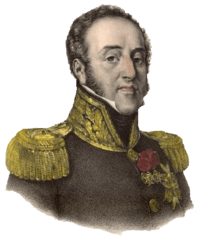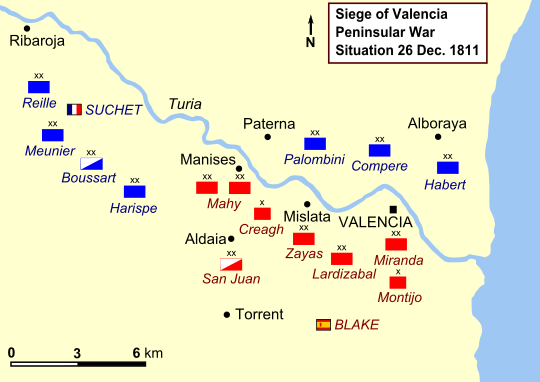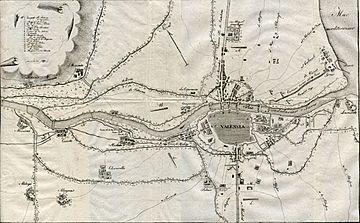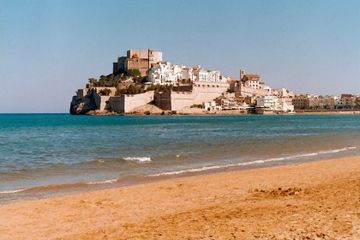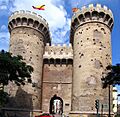Siege of Valencia (1812) facts for kids
Quick facts for kids Siege of Valencia (1812) |
|||||||
|---|---|---|---|---|---|---|---|
| Part of Peninsular War | |||||||
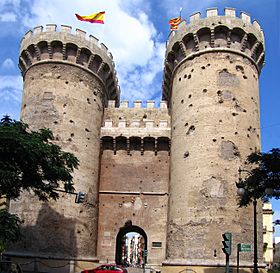 One of Valencia's twelve old city gates |
|||||||
|
|||||||
| Belligerents | |||||||
| Commanders and leaders | |||||||
| Strength | |||||||
| 20,595–33,000 | 28,044-33,000 | ||||||
| Casualties and losses | |||||||
| 2,000 | 20,281-21,400 374-455 guns |
||||||
The Siege of Valencia was a major event during the Peninsular War. It happened from December 26, 1811, to January 9, 1812. During this time, French forces led by Louis Gabriel Suchet surrounded the city of Valencia, Spain. Inside Valencia, Spanish troops were commanded by Joaquín Blake y Joyes.
About 20,000 to 30,000 French soldiers attacked the city. They forced around 16,000 Spanish soldiers to give up. However, about 7,000 Spanish soldiers managed to escape. After this victory, Valencia became an important base for the French army. Valencia is a city on the east coast of Spain and is the capital of the Valencian Community today.
Contents
How the Siege Started
In July 1811, a French general named Suchet was given a special honor. He became a Marshal of France, which is a very high rank in the French army. He earned this for winning battles in Spain, especially the siege of Tarragona.
The port city of Tarragona was captured by the French on June 29, 1811. British ships nearby could not help. Suchet's army lost about 4,300 soldiers in this battle, but the Spanish lost many more. Losing Tarragona weakened the Spanish forces in that area a lot.
Emperor Napoleon I of France then ordered Marshal Suchet to capture Valencia. Over the next few months in 1811, Suchet's army took control of Montserrat. They also defeated General Blake again at the Battle of Saguntum on October 26. Suchet was hurt in the shoulder during this battle. With more soldiers joining them, the French army kept moving forward.
The Siege of Valencia Begins
Marshal Suchet had about 20,595 soldiers. These included five groups of infantry (foot soldiers), plus cavalry (horse soldiers) and artillery (cannons). Some of his soldiers were from France, while others were from places like the Kingdom of Italy and the Kingdom of Naples. Some reports say Suchet had even more soldiers, possibly up to 33,000.
General Blake had about 28,044 Spanish soldiers defending Valencia. His army was split into three main parts. These included foot soldiers and horse soldiers, along with cannons.
Blake set up his army to face north. His right side was near the coast, and his left side was at a place called Manises. The Spanish lines were protected by canals and ditches. However, Blake's far left side was not well protected.
Suchet quickly saw that Blake's left side was the weakest point. He decided to attack there and surround the Spanish army. On the night of December 25, Suchet led his main group of soldiers across the Rio Túria river.
At first, Blake thought the main French attack was on his right side. Then, another French attack at Mislata also caught his attention. These attacks were meant to distract him. Suchet's main group of soldiers then moved around to Blake's unprotected left side, almost without anyone stopping them.
As the French moved in, they found the Spanish cavalry (horse soldiers). A small group of French horsemen bravely attacked a much larger Spanish force. They were defeated, but soon more French cavalry arrived and scattered the Spanish horsemen. This left Blake's army without important cavalry support.
General Nicolás de Mahy, who was in charge of the Spanish left side, realized his soldiers were about to be surrounded. He ordered them to retreat right away. Some Spanish divisions managed to escape to the south. However, Blake ordered his best soldiers to go inside Valencia. These experienced units got into the city, but they were now trapped. Suchet quickly surrounded the city with his army.
Valencia had a population of 100,000 people. The city did not have enough food, and its defenses were old. It was not ready for a long siege. On the night of December 28, Blake tried to break out of the city. Most of his soldiers failed, but about 500 managed to get away.
Suchet did not waste any time. On January 1, his soldiers began digging trenches closer to the city. Three days later, they started firing cannons at the city's outer defenses. As the bombing got stronger, Blake decided to surrender. Valencia was handed over to the French on January 9.
What Happened After
The French lost about 2,000 soldiers who were killed or wounded. In return, they captured 16,270 Spanish soldiers, 21 flags, and 374 cannons. Another 4,011 Spanish soldiers died in battle or from sickness. Blake's cavalry and some other units escaped, but his best troops were captured.
Many people in Valencia were unhappy with Blake because he did not defend the city well. The French kept General Blake as a prisoner near Paris until 1814. Suchet made the city of Valencia pay a huge amount of money, about 53 million francs.
Suchet continued to move south and captured the port of Dénia. However, Napoleon started moving soldiers from Spain to prepare for his invasion of Russia. This meant Suchet's army did not have enough soldiers to keep going. Suchet also became very sick and was out of action for weeks. This allowed the remaining Spanish army under General Mahy to recover.
Meanwhile, Napoleon gave Suchet a special title: Duke of Albufera. This name came from a lagoon south of Valencia.
Further north, Spanish forces continued to fight. For example, on January 18, 1812, Spanish troops captured a French battalion near Tarragona. Out of about 850 French soldiers, only a few escaped. However, a week later, the French got their revenge. On January 24, in the Battle of Altafulla, the French defeated a Spanish force, causing them to lose many soldiers.
On January 20, another French general began to surround Peñiscola. This port city was known as "Little Gibraltar" because it was very strong. However, the Spanish commander there was friendly with the French. He quickly surrendered the castle on February 2, and his 1,000 soldiers were captured.
Later in 1812, Arthur Wellesley, 1st Duke of Wellington (a British general) won a big victory against the French at the Battle of Salamanca. This caused King Joseph Bonaparte (Napoleon's brother, who was King of Spain) to leave Madrid. Joseph and other French marshals met with Suchet in Valencia. They planned to take back Madrid and push Wellington out of central Spain. Their plan worked, and Wellington had to retreat to Portugal later that year.
Images for kids
See also
 In Spanish: Sitios de Valencia (Guerra de la Independencia Española) para niños
In Spanish: Sitios de Valencia (Guerra de la Independencia Española) para niños


